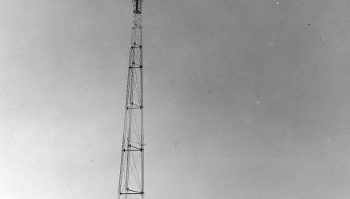Once the primary transmission medium for the BBC World Service, Voice of America and Radio Moscow, the shortwave radio bands — 1,800 to 30,000 kHz — are becoming less important to the foreign policy goals of many governments. At the same time, the millions of listeners who used to tune to shortwave are also abandoning the bands.
“In North America, Europe and the Far East, the shortwave audience has declined massively,” said Andy Sennitt, longtime shortwave radio watcher and editor in charge of the Radio Netherlands “Media Network” website. “In other regions, such as Africa and South Asia, its decline is less rapid, but audiences are still falling significantly.”
“In India, ‘yesterday listening’ to any shortwave dropped from 7.4 percent to 2.3 percent from 2003 to 2008,” said Kim Andrew Elliott, audience research analyst with the U.S. International Broadcasting Bureau (IBB). “Yesterday listening” refers to people’s answers to the question, “what radio stations did you listen to yesterday?”)
Africa is even worse: “In Kenya, ‘yesterday listening’ to any shortwave dropped from 25 percent to 3 percent from 2003 to 2011,” Elliott said.
CHANGING NEEDS
Since the end of the Cold War, changing listener needs, the expansion of private radio, and the concurrent growth of FM radio significantly changed the radio markets of Europe and beyond. However, shortwave radio remained valuable for many people in developing nations.
The receivers were relatively cheap, and served as lifelines for audiences with minimal domestic media. Add the hobbyists worldwide who relied on shortwave for news from around the globe — seen by foreign governments as politically important decisionmakers in their home countries — and the shortwave bands remained alive well into the 1990s.
Unfortunately for shortwave radio, it is expensive to operate the aging high-power transmitters used to send transmissions around the world, making shortwave broadcasts a luxury as budgets contract and austerity programs are put in place.
Even when such broadcasts were retained, the sound quality was generally poor, thanks to its use of AM signals being thrown over long distances. Add in interference and signal fading, and shortwave listening made local medium-wave broadcasts sound like FM by comparison.
Still, when there were no options to shortwave’s combination of open information and global reach, the medium thrived. But today, times have changed.
For instance, “More people have access to television,” says Kim Andrew Elliott. “Many people around the world can watch CNN International, Al Jazeera, and other international channels for news.”
Once these television news sources went global, shortwave lost its informational monopoly.
“To young people, shortwave is old-fashioned, like a wind-up gramophone,” Andy Sennitt said.
The result: “Shortwave is not being picked up by today’s listeners,” said André Mendes, CIO and director of technical innovation at the U.S. Broadcasting Board of Governors, which oversees the IBB and VOA. “They are moving to domestic radio, TV, the Web and mobile phones,” Mendes said, “and we are going where they are.”
STILL RELEVANT
This said, not everyone buys the notion that shortwave radio is doomed to irrelevance.
One of the skeptics is Jeff White, general manager of commercial shortwave station WRMI in Miami, Florida. He established WRMI in 1994, and has helped other U.S. religious and commercial broadcasters set up stations through the National Association of Shortwave Broadcasters (NASB).
“I think the proclamations by some of the major international broadcasters that they are reducing or eliminating their shortwave transmissions because the shortwave audience is declining are self-fulfilling prophesies,” said White.
“They say that not as many people are listening to them on shortwave as before, but often that’s because they have been steadily cutting back on their shortwave broadcasts for some time.”
The BBC World Service and VOA are among many state-run broadcasters facing budget cuts. In coping with them, they have opted to slash shortwave radio in favor of newer technologies.
A case in point: Both the BBC WS and VOA have ceased their Mandarin-language broadcasts to China, despite that country’s control over domestic media — and its blocking of foreign Internet sites that contradict its ideologies. The cuts are not total, however, with the BBC WS is continuing its Cantonese-language broadcasts to China, and the IBB-run Radio Free Asia broadcasting from the United States to China in Mandarin.
Jeff White said he thinks such cuts are shortsighted.
“Shortwave absolutely has a major place in reaching countries where the domestic media are totally controlled by totalitarian governments, like North Korea and Cuba,” he said. “In most of these countries, the Internet is not available to most citizens, and even if some of them have access, it is limited. Websites with anything derogatory to the regime are blocked, so shortwave is about the only way to reach these populations.”
STILL ON SHORTWAVE
And not all nations are pulling back from shortwave.
“Incidentally, while Western shortwave stations have been cutting back, China Radio International has been expanding its shortwave operation greatly through their own transmitters and a lot of purchased relay time from overseas transmitters,” said White. “[Venezuelan President] Hugo Chávez is building a large new shortwave transmission facility in Venezuela with the help of the Chinese. … I can’t fault these countries for realizing the marketing power that shortwave has for them.”
Afghanistan and several other nations, as well as religious broadcasters, are making an increasing use of shortwave. In Europe, some private broadcasters periodically look to shortwave as a transmission option. Commercial music broadcaster KBC Radio, based in the Netherlands, is looking to return to shortwave in November 2011.
Kim Andrew Elliott said he believes shortwave radio still matters in the Internet Age. In fact, “As more nations develop more powerful methods to block Internet content, shortwave can come to the rescue,” he said. “This would probably be by means of text via shortwave, which is a much more efficient mode than voice. Text via shortwave can be used to get uncensored news to a few key users in a country, who can in turn pass the information on via blogs and social media within the country.”
While shortwave fans may not cheer the lesser amount of programming on the wave bands these days, there is one advantage for DXers.
“The reduction in frequency hours by other international broadcasters might permit reception of low power DX signals that used to be blocked by stronger signals, so for the hobbyist there’s still plenty left to hear,” Sennitt said.












